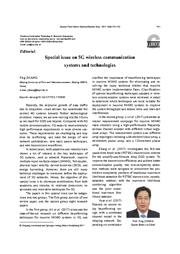Special issue on 5G wireless communication systems and technologies
Ping Zhang
2017
Frontiers of Information Technology & Electronic Engineering
Recently, the explosive growth of data traffic due to ubiquitous smart devices has accelerated the current 4G systems towards further technological evolution. Indeed, we are now moving into the 5G era as we reach for 2020 and beyond. Compared with 4G mobile communications, 5G needs to meet extremely high performance requirements in more diverse scenarios. These requirements are challenging and may even be conflicting, and need the design of new network architectures, new radio access
more »
... and new transmission waveforms. In recent years, both academia and industry have shown a lot of interest in the key techniques of 5G systems, such as network framework, massive multiple-input multiple-output (MIMO), full-duplex, physical layer security, device-to-device (D2D), and energy harvesting. However, there are still many technical challenges to overcome before the deployment of 5G networks. Hence, the objective of this special issue is to showcase contributions from both academia and industry to motivate discussions on advanced and innovative techniques for 5G. The papers in this special issue can be categorized into two groups. The first group consists of one review paper, and the second group eight research papers. In the first group, Ali et al. (2017) discussed the state-of-the-art research on different beamforming techniques for massive MIMO systems in 5G, and clarified the importance of beamforming techniques in massive MIMO systems for eliminating and resolving the many technical hitches that massive MIMO system implementation faces. Classifications of optimal beamforming techniques adopted in wireless communication systems were reviewed in detail to determine which techniques are more suitable for deployment in massive MIMO systems to improve the system throughput and reduce intra-and inter-cell interferences. In the second group, Li et al. (2017) presented an indoor measurement campaign for massive MIMO radio channels using a high-performance frequency domain channel sounder with different virtual largescale arrays. The measurement system uses different array topologies including a 64-element linear array, a 64-element planar array, and a 128-element planar array. investigated the full-rate space-time block code (FSTBC) transmission scheme for the amplify-and-forward relay D2D system. To improve the transmission efficiency and achieve better communication quality, two low-complexity detection methods were designed to circumvent the prohibitive complexity problem of traditional maximum likelihood detection for FSTBC transmission, namely, detection methods with the maximum likelihood combining algorithm and the joint conditional maximum likelihood detector. Yuan et al. (2017) focused on secure relay beamforming design with a correlated channel model in the relaying network. Depending on correlation Editorial:
doi:10.1631/fitee.1720000
fatcat:fpll6q4ebvfgvonwi4vvetzjlq

